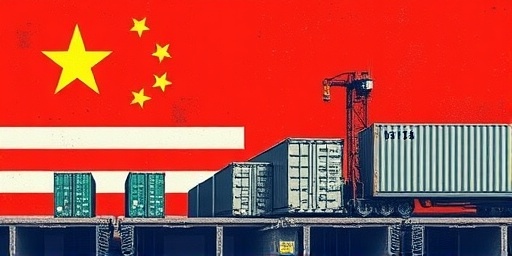In a stark warning to the business world, Craig Fuller, CEO of FreightWaves, has declared that key portions of the U.S. Goods economy are in freefall, battered by relentless tariff uncertainty that is paralyzing supply chains and eroding profitability. Speaking at a recent industry conference, Fuller painted a grim picture of how fluctuating trade policies are forcing U.S. businesses to rethink operations, with immediate consequences rippling through manufacturing, logistics, and retail sectors.
- Fuller Exposes Tariff Turmoil’s Grip on Supply Chains
- Sectors in the Crosshairs: Manufacturing and Agriculture Lead the Decline
- U.S. Business Leaders Echo Fuller’s Call for Tariff Clarity
- Navigating the Storm: Strategies for Businesses Amid Tariff Volatility
- Future Horizons: Rebuilding the Goods Economy Beyond Tariffs
Fuller Exposes Tariff Turmoil’s Grip on Supply Chains
Craig Fuller’s comments come at a pivotal moment for the U.S. economy, as businesses grapple with the aftermath of prolonged tariff wars initiated during the Trump administration and largely maintained under President Biden. Fuller, whose company FreightWaves provides real-time data and analytics on freight markets, emphasized that the unpredictability of tariffs—ranging from 25% on steel imports to proposed hikes on Chinese goods—is creating a chokehold on the Goods economy. ‘We’re seeing a collapse in certain segments because companies can’t plan beyond the next policy tweet or executive order,’ Fuller stated in an exclusive interview. This uncertainty, he added, has led to a 15% drop in freight volumes for affected industries over the past year, according to FreightWaves’ proprietary SONAR data platform.
The tariffs, designed to protect domestic industries, have instead amplified economic downturn risks. For instance, the Section 232 tariffs on aluminum and steel have inflated costs for downstream manufacturers, with the American Iron and Steel Institute reporting an additional $10 billion in annual expenses for U.S. businesses since 2018. Fuller’s analysis points to a vicious cycle: higher input costs lead to reduced orders, slower shipments, and ultimately, layoffs in logistics hubs like Chicago and Dallas. ‘The Goods economy isn’t just slowing—it’s fracturing,’ Fuller warned, highlighting how small and medium-sized enterprises, which form the backbone of U.S. business, are hit hardest due to limited hedging capabilities against trade volatility.
FreightWaves’ role in this narrative cannot be overstated. As a leading provider of supply chain intelligence, the company tracks over 500 data points daily, offering insights that reveal the tariff-induced disruptions in real time. Fuller’s leadership has positioned FreightWaves as a go-to source for understanding how tariffs are reshaping the economic downturn, with recent reports showing a 20% year-over-year decline in intermodal freight activity tied to tariff-sensitive imports.
Sectors in the Crosshairs: Manufacturing and Agriculture Lead the Decline
At the epicenter of this turmoil are manufacturing and agriculture, two pillars of the U.S. goods economy now reeling from tariff pressures. Fuller singled out the automotive sector, where tariffs on imported parts have driven up vehicle production costs by an estimated 5-7%, according to the Alliance for Automotive Innovation. ‘U.S. business in manufacturing is pausing investments because no one knows if a new administration will double down on tariffs or roll them back,’ Fuller explained. This hesitation has contributed to a 3.2% contraction in industrial production last quarter, as reported by the Federal Reserve.
Agriculture faces even steeper challenges. Tariffs retaliated against by China have slashed U.S. soybean exports by 75% since 2017, devastating Midwestern farmers and related logistics firms. FreightWaves data indicates a 25% reduction in agricultural freight tonnage moving through ports like New Orleans, exacerbating the economic downturn in rural economies. ‘These aren’t just numbers; they’re family farms shutting down and truckers idling their rigs,’ Fuller noted, underscoring the human cost. The U.S. Department of Agriculture corroborates this, projecting a $27 billion loss in farm income directly attributable to trade disputes.
Retailers are not spared either. With tariffs inflating the price of consumer goods from electronics to apparel, big-box stores like Walmart and Target have reported margin squeezes, leading to cautious inventory management. Fuller’s insights reveal that e-commerce fulfillment centers are seeing a 10% uptick in storage costs due to delayed imports, forcing U.S. business owners to diversify suppliers at great expense. In a broader context, the Consumer Price Index for goods rose 4.1% in the last year, partly fueled by these trade barriers, eroding consumer confidence and spending power.
- Key Impacted Areas: Automotive parts (cost increase: 6%), Soybean shipments (export drop: 75%), Retail imports (inventory delays: 2-3 weeks average).
- FreightWaves Metrics: Overall goods economy freight index down 12% amid tariffs.
These sector-specific woes illustrate how tariffs are not just a policy tool but a disruptor of the entire goods economy ecosystem, prompting calls for more stable trade frameworks.
U.S. Business Leaders Echo Fuller’s Call for Tariff Clarity
Fuller’s pronouncements have resonated widely among U.S. business leaders, who are increasingly vocal about the need for predictability in trade policy. At the conference where he spoke, panelists from the U.S. Chamber of Commerce echoed his concerns, with Executive Vice President Myron Brilliant stating, ‘Tariff uncertainty is the invisible tax that’s stifling innovation and growth in the goods economy.’ This sentiment is backed by a recent survey from the National Association of Manufacturers, where 68% of respondents cited trade policies as their top barrier to expansion.
Economists are weighing in too. Dr. Elena Ramirez, a trade expert at the Brookings Institution, analyzed FreightWaves data and concluded that the ongoing economic downturn could deepen if tariffs escalate post-election. ‘We’ve already lost 300,000 manufacturing jobs since the tariff escalations began,’ she said, referencing Labor Department figures. Fuller’s FreightWaves platform has been instrumental here, providing dashboards that correlate tariff announcements with immediate freight rate spikes—up 18% in tariff-impacted lanes like those from Shanghai to Los Angeles.
Small business owners, often overlooked in macro discussions, are feeling the pinch acutely. Take Johnathan Hale, owner of a Midwest metal fabrication shop: ‘Tariffs turned my $50,000 steel order into $65,000 overnight. Now, I’m laying off workers because clients are pulling back.’ Stories like Hale’s are proliferating, as FreightWaves’ community forums buzz with similar accounts from U.S. business operators navigating the economic downturn. The company’s CEO has leveraged these narratives to advocate for policy reforms, including a proposed ‘Tariff Stability Act’ that would require congressional approval for major changes.
- Survey Highlights: 68% of manufacturers view tariffs as primary growth hurdle.
- Job Losses: 300,000 in manufacturing linked to trade policies.
- Freight Rate Impact: 18% increase in key import routes.
This chorus of voices underscores the urgency for Washington to address how tariffs are undermining the resilience of U.S. business.
Navigating the Storm: Strategies for Businesses Amid Tariff Volatility
As the goods economy teeters, Fuller and FreightWaves are not just diagnosing the problem—they’re offering solutions. In his address, Fuller outlined practical strategies for U.S. businesses to mitigate tariff risks, starting with supply chain diversification. ‘Move away from single-country dependence; look to Mexico or Vietnam for alternatives,’ he advised, noting that nearshoring has boosted freight volumes to Mexico by 22% per FreightWaves data. This shift, while costly initially, could save companies 10-15% on duties long-term.
Technology plays a starring role in Fuller’s playbook. FreightWaves’ AI-driven tools help firms forecast tariff impacts, with features like the Tariff Tracker alerting users to potential cost hikes weeks in advance. ‘In an economic downturn driven by policy whims, data is your best defense,’ Fuller emphasized. Case in point: A FreightWaves client in the electronics sector rerouted 40% of its imports via Canada, dodging a 25% China tariff and maintaining profitability.
Government intervention is another avenue. Fuller called on policymakers to extend tariff exclusions for critical goods, a move that could inject $5 billion back into the goods economy, per estimates from the Peterson Institute for International Economics. Meanwhile, U.S. business associations are lobbying for WTO-compliant reforms to reduce uncertainty. Fuller’s influence extends here, as FreightWaves partners with think tanks to produce white papers that shape these debates.
Environmental and sustainability angles are emerging too. Tariffs have inadvertently pushed some U.S. businesses toward greener practices, like sourcing domestic recycled materials to avoid import duties. However, Fuller cautions that without clarity, these adaptations could falter, prolonging the economic downturn.
Future Horizons: Rebuilding the Goods Economy Beyond Tariffs
Looking ahead, the trajectory of the U.S. goods economy hinges on the 2024 election and subsequent trade agendas. Fuller predicts that a resolution to tariff uncertainties could spark a 10-15% rebound in freight activity by mid-2025, but warns of deeper recession risks if escalations continue. ‘The economic downturn we’re seeing is reversible, but it requires bold action from leaders,’ he said.
For U.S. business, the path forward involves resilience-building: investing in domestic production incentives like the CHIPS Act, which has already funneled $52 billion into semiconductors, partially offsetting tariff pains. FreightWaves is expanding its offerings with predictive analytics for post-tariff scenarios, helping companies simulate outcomes under different policy regimes.
Ultimately, Fuller’s message is one of cautious optimism. By addressing tariff-induced fractures, the goods economy can not only recover but thrive in a more balanced global trade landscape. As businesses adapt and policymakers deliberate, the coming months will test the mettle of American innovation amid ongoing uncertainties.









